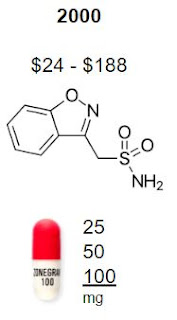Zonisamide (Zonegran)
Excerpt from Cafer's Mood Stabilizers and Antiepileptics
Zonisamide (ZONEGRAN)
Pronunciation: zoe NIS a mide / ZAHN uh gran
“Zone is mighty, Zone is grand”| ❖ Antiepileptic ❖ Voltage-gated sodium channel blocker ❖ Glutamate ⇩ | FDA approved for: ❖ Focal seizures | Used off label for: ❖ Other types of seizures ❖ PTSD nightmares ❖ Sleep-related eating disorder ❖ Obesity ❖ Binge eating disorder ❖ Alcohol use disorder ❖ Migraine prophylaxis ❖ Parkinsonian symptoms associated with Lewy body dementia |
Zonisamide (Zonegran) is a broad-spectrum antiepileptic drug (AED) that blocks sodium and calcium channels and increases dopaminergic and serotonergic transmission. It is unrelated to other antiseizure medications.
Zonegran can cause weight loss:
Zonisamide decreases appetite and has been shown to decrease binge-eating. Cognitive impairment including “brain fog”, confusion, difficulty concentrating, and word-finding difficulty are relatively common. It is not used as a mood stabilizer because it may cause irritability. There have been rare cases of zonisamide-induced psychosis.
Due to carbonic anhydrase inhibitor activity (although weak) there is a chance of kidney stones (4%) and metabolic acidosis. Aplastic anemia and agranulocytosis have been reported. Stevens-Johnson syndrome (SJS) and toxic epidermal necrolysis (TEN) have been reported. Oligohidrosis (decreased ability to sweat) has occurred with children.
Half-life is over 60 hours. About 30% is excreted unchanged in the urine.
Zonisamide has a sulfonamide structure. It is contraindicated in patients allergic to sulfa drugs. Other sulfonamides include the antibiotic sulfamethoxazole (Bactrim, Septra) and the disease-modifying antirheumatic drug (DMARD) sulfasalazine.
Dosing: Start 100 mg daily. May increase by 100 mg q 2 weeks for a maximum of 600 mg. However, doses above 400 mg are rarely more effective. As with any antiepileptic medication, taper dose gradually to discontinue.
| Dynamic interactions: ❖ Sedative (mild) ❖ Hypokalemia ❖ Metabolic acidosis ❖ Decreased renal perfusion | Kinetic interactions: ❖ Kinetic interactions: ❖ Urine alkalization (minor) ❖ 3A4 substrate (minor) |








Comments
Post a Comment